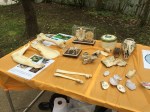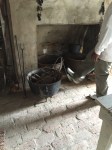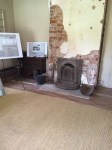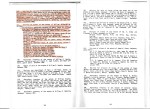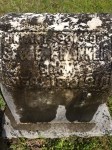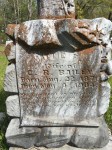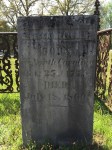My 2016 Year of Genealogical Firsts in Review
It’s been awhile since I’ve written a blog post but that doesn’t mean I haven’t been busy I have had an incredibly full year of “firsts”!
My research has been sporadic due to the brick walls on my maternal side, being unable to advance beyond 2nd grandparents has been a constant source of frustration. On the other hand once the tears and screaming have ceased I find solace on my paternal side, which has been very fruitful!
Speaking of fruitful, while rereading my notes for this post I have come to the conclusion that with all of the genealogy related events that have occurred in 2016, this post will need to be in two parts because this has been a year of numerous firsts! Yes, I’ve been just that busy.
My mother was born in Galveston, Texas but she hadn’t been back since she was a young girl. She and her sister owned land there that had been passed down from their grandmother. In March of 2016 we decided to fly down and check on the status of the land and visit with her 1st cousin, Franceta Harkins. We learned that she hadn’t been feeling well.
Franceta had called all of her children to come meet her cousin Anne and their cousin Donna. We had met her daughter Racheal, years before but had never met her sons, Anthony and Bert. This was a first for my mother and me and we enjoyed our visit tremendously! It was fortunate we chose that time to visit because Franceta journeyed to be with her Ancestors a week later.

In April I discovered I needed some more records from Corydon, Indiana, where my paternal family is from, and so – road trip!
DNA and research led me to make a connection to three paternal cousins, Damita Parrish, Chuck Alexander and Adrieanne McAllister and to also discover who our common Ancestor is. The Ancestors were working overtime because I was able to meet Damita, Chuck and his family and Adrieanne’s dad, James Allen, who I affectionately call “Cousin Daddy”.



I’m going to back up a bit to 11 August 2015 because this was the beginning of another first that would happen 11 August 2016. One year to the day.
While checking out my matches on GEDmatch, I saw a name that was also in my DNA matches on FTDNA, 23andMe as well as Ancestry. I knew it was from my paternal side because they didn’t match my mother or my aunt. I sent her a quick email noting that she fell on my paternal side and expressing a hope that we could work together to discover our common Ancestor. That was 11 August 2015.
She responded 13 August 2015 with trepidation and a wonderful story. Here in part is her response.
“Hi Donna! I can’t even begin to tell you how happy I am to hear from you! I noticed our connection on Ancestry, FTDNA and 23andme, but was not sure about the protocol of trying to contact you. I am very new to this and have not taken the time yet to obtain some much needed education on reading DNA results.
Sadly, I’m afraid I’m not going to be able to be much assistance to you in your search for ancestry. I’m adopted.”
To be continued!
In Search of Ancestors in Holly Springs, Mississippi

On 8 April 2015 I set out on a research trip that turned into a wonderful journey, one in which the Ancestors were whispering in my ear and nudging me all over Holly Spring, Mississippi! It wasn’t just my Ancestors who were whispering and nudging, but Ancestors of friends and fellow researchers who are part of the Holly Springs Mississippi Facebook Group page.
Before I go any further I must thank a few very important people who made this trip not only productive but enjoyable!
I would like to thank Bobby Mitchell, without him guiding me to The Last Road to Freedom by Dr. Alisea Williams McLeod, I would never have discovered my great, great-grandfather, Champ Franklin in the Contraband Band Camp at Corinth. Wherever I went in – from the court-house to the library – asking questions, they all referred me to Bobby. They said, “You need to talk to Bobby Mitchell, he knows everything about our history!” Yes, Bobby is the resident expert on all things Holly Springs and I can’t wait to return to chat with him again!

I wish to thank Dr. Alisea Williams McLeod for the wonderful work she is doing transcribing the Register of slaves at the various Contraband Camps. Such a daunting project that she has undertaken – one that gives a glimpse into the lives of former slaves who fled with and followed the Union Army during the war. This project has provided Black genealogists searching for their Ancestors, names of their kin who were enslaved, names of their former owners and their last location. This alone is reason to scream for joy because slaves were not listed by name in the census until 1870, this makes tracing them very difficult.
What a treat it was for me to meet this phenomenal woman, thank you so much Alisea for the work you are doing! I’m proud to have met you!

Last but certainly not least, is Joseph McGill, and his Slave Dwelling Project. I first decided to visit Holly Springs when I saw that he would be there as part of one of his projects; Behind the Big House: a Slave Dwelling Tour in conjunction with Holly Springs Home & Heritage Festival and Pilgrimage. I began following Mr. McGill on Facebook because I thought what he was doing was not only fascinating but very important, bringing attention to how and where the slaves lived. By bringing attention to these dwellings he is helping to preserve a part of history that you won’t find in any history book. Here’s an article in the Smithsonian Magazine about Mr. McGill’s project One Man’s Epic Quest.
Meeting Joseph was fun and informative and he even took a selfie with me! Thank you Joseph for the work you are doing, I look forward to seeing you again soon!
The Journey Begins
8 April
My flight to Memphis was delayed by several hours in Chicago. Because of this, my original plans for the first day of research had to be adjusted. After picking up the rental car I drove to Collierville, Tennessee, which would be my home base. I had originally planned to stay in Holly Springs but Anthony “Tony” Ryan, a member of the Facebook page, warned me that the hotel I planned to stay in was not a good idea for several reasons. I made arrangements to stay at the Courtyard, a much cleaner place! It pays to ask for recommendations for lodging when planning a research trip; you don’t want to end up in a dump or in a part of town that may not be safe!
I called Bobby to let him know I had arrived and we made plans to meet at the library in town. This was our first face to face meeting after sharing emails for so long! We spent a little time chatting but since it had been such a long day I decided to head back to the hotel. Since there was still some daylight left I decided to make a quick stop at the first cemetery on my list, Strawberry Plains Cemetery. Roaming among the resting places of these people, I had mixed emotions; peaceful, excited, thoughtful and sad. I was sad because the cemetery was unkempt, headstones had fallen over, some had sunk into the ground making them unidentifiable and yet others were buried under ant mounds. These are a few surnames of the people whose headstones I took pictures of: Perkins, Pegues, Rankin, Hymon and Chapel.
I needed to eat. Driving to the hotel, I found a sweet little place called Sophie’s on HWY 311 just outside of Holly Springs, that had the best apple cobbler I’ve tasted in a long time!
Later that evening via Facebook private message, Tony connected me with Catherine Wilson, a fellow researcher who lives in Memphis. Catherine and I clicked right away during a late night phone conversation and made plans to meet in the morning to visit some of the cemeteries that were on my list.
9 April
Once Catherine arrived we got on the road, me with my spray bottle of water and paper towel because I forgot my soft bristle brush at home..sigh. Sometimes headstones are damaged by age, weather and man, the safest way to clean them is with plain old tap water and a soft bristle brush to lightly brush away surface dirt.
First stop was the Strawberry Plains Cemetery, 2602 hwy. 311. I had my list of names to search for and managed to find more than a few of the headstones I was looking for.
Our next stop was Hudsonville CME Church Cemetery on Slayden Rd. just south of Highway 72. Hudsonville is an unincorporated community located in the hill country of north Mississippi.
These are the surnames I was tasked with locating headstones for: Pennington/Penilton, Luellen/Lewellen, McFadden, Raimey/Ramey, Cowan/Cowans and Jones. A few of the other names I located that made me happy were Franklin and Holland! I’m working on seeing if these families crossed paths, they are both from the maternal side of my family.
After I provided a hearty meal to the mosquitoes, Catherine and I decided to visit the Corinth Civil War Interpretive Center. Corinth is actually in Alcorn County, Mississippi and is its county seat.
We left the Interpretive Center and drove down the road a piece to the Contraband Camp.
Corinth Contraband Camp was the place I most wanted to visit. I walked on the ground that my great, great-grandfather, Champ Franklin walked on, I wondered what a 15-year-old boy who had fled a slave and was now free would be thinking, feeling. Had his mother and father fled with him? Was his father taken by the Union soldiers to go fight a war that they barely understood? Did he have enough to eat, was he warm at night, did he have enough clothes to cover him, did he have a roof over his head? Did he have someone to comfort him? As a mother and a grandmother these were my immediate thoughts.
Despite knowing that this Camp was one of the better run camps, I was overwhelmed with feelings of pain and sorrow for what this young man had to endure in his short life. But I also felt a tremendous amount of pride! He survived! He lived through it all! I believe his ability – no, his determination – to survive is a family trait that has been passed on through his genes, passed on to him by his Ancestors who were brought over in chains! I could feel his spirit and those of approximately 6,000 plus men, women and children who called this place home. I believe if I had listened very closely I would have heard them say, “Welcome daughter, tell our stories, don’t let us be forgotten.”
Champ is not listed with any family members in the Contraband Camp Register.

fig.1
As the family historian, I looked around at the trees and wondered if they were there between 1863-64? I had to take lots of pictures so that I could share them with my mother, my children and my grandchildren. Were any of the other Franklins’ that were listed in the Register related to Champ? What were the logistics of this camp, how were all those people provided for?
This day will forever be in my heart!
I had been invited to a reception being held in town – time to head back and get ready. It was here that I was introduced to Dr. Aliesa Williams McLeod and Mr. Joseph McGill. What a great way to end an awesome day!
10 April
I was dragging Thursday morning and didn’t get as early of a start as I had planned but I had to stop at Ihop for blueberry pancakes! I never pass up a chance for blueberry pancakes!
I drove into town for the Slave Dwelling Tour; after all I hadn’t come all the way from Chicago to miss this! My first stop was the Hugh Craft House, 184 S. Memphis St. The house was built in 1851 but the Slave dwelling was built about 1843. It was built for the family while they were waiting for the big house to be completed.
The fireplace you see that has been closed in is where the slaves cooked for themselves and their owners, this was the kitchen for the big house.
There was an archaeological field study going on at this house, conducted by Dr. Carolyn Friewald, Professor of Anthropology & Archaeology at the University of Mississippi. She believed that there had been a brick walkway that was covered and connected to the house at one time. They were discovering bones of animals most likely from the meals that were made and fragments of pottery probably used by the former occupants.
The Burton Place, 248 S. Memphis St. was my next stop. For me this was the most interesting Slave dwelling. Built in 1848 it also had a detached kitchen but there were three rooms that were much better preserved.
There were only two rooms open to the public but I had an opportunity to see the third room.
Can you see the ring on the wall? I was told that a misbehaving slave would be tied up to it for “punishment.”
The last house on my list was the Magnolias, 305 Craft St. This house was built in 1852 and as all the other dwellings had a detached kitchen which was located in the slaves quarters. Various property owners had done a lot of rebuilding and modernization.
I had not done any paper research yet so a stop at the court-house was in order. A wonderful young woman, whose name I’m sorry to say I didn’t get, was very helpful. I explained I was attempting to locate the Franklin land, I mentioned Champ Franklin. She pulled out a book, Marshall County, Mississippi Probate and Will Records, Betty C. Wiltshire. In this book she found a four-year old boy named Champ mentioned in the inventory and will of a William Jefferies!
The first image is that of an index listing of the Will of William Jefferies dated June 30, 1852 and probated August 1852 and the appraisers inventory of his estate. Circled you see, “boy Champ”. This inventory was taken in October 1852. The second image is a petition for division of the estate listing his wife and children, dated September 1856. It also indicates to which family member these Slaves would be given to. William G. Jefferies was to receive eight Slaves; “Abraham, 40 years, Sophy 30, Ellison 13, Terril 9, Champ 4, Lucy 8, Elmira 6, Dinah 2,”. The last image addresses which of the Slaves will go to the minor children of William Jefferies.
There appears to be an error in the transcription of this last inventory, in particular the name “Chaness, a boy 5 years” I have a copy of the will and in the section that addresses the division of the Slaves to the minors, I can find no Slave by that name but the age matches that of what Champ would be in 1857.
The age is right, Champ was born about 1848-49.Who is this Jefferies? Is this my Champ? Was Champ purchased by Franklin from the Jefferies estate? This information churned up more questions and another surname to research! The courthouse was closing so much to my dismay I had to leave.
11 April
Beverly Harper, one of the Facebook group members had requested that I look for Hopewell #2 Cemetery. A search on Google brought up an address but Google maps showed nothing. I took a chance, drove out there and there it was! Hopewell #2 M.B. Church is located at 239 HWY 313.
Hopewell’s cemetery is situated all the way at the far end of their property which is probably why it didn’t show up on Google maps. Since it wasn’t a big cemetery I was able to get pictures of all the headstones and grave markers for Beverly.
The next cemetery on my list was Slayden Cemetery. Slayden is another of Mississippi’s unincorporated communities along 72 on the northeast corner of Marshall County.
Here I was looking for Pegues, Lewellyn/Lewelling, any spelling, Bailey and Howell. One of the genealogical benefits of visiting cemeteries is that you learn who married into what family if you’re lucky! For example, the Howells’ married into the McKinny family. I know this because the family of Mrs. Mary McKinny put her maiden name, Howell, on the grave marker. Just this bit of information for researchers can break down a brick wall leading to a wealth of records!
There are some of us who talk about the Ancestors talking to us or guiding us to them because they want to be found and remembered. Well this next leg of my journey, I think, put the truth to this sentiment!
I was leaving Slayden Cemetery and just looking around when I spotted a sign just a bit back from the road. I pulled over and backed up to see what it was; Early Grove United Methodist Church.
Early Grove is another unincorporated community of Marshall County along 72.
The Franklin plantation was in Early Grove! Did they have a cemetery?! Down the road I went, hoping, praying…yes!! Pay Dirt baby! With very little effort I discovered the headstone of the man I believe was Champ’s last owner, Bernard Franklin, his wife, mother, father and what appeared to be headstones for very young children. Was this the land Champ worked and Bernard owned? More research will answer those questions.
Here I was standing alongside the final resting place of the man who may have owned my great, great grandfather.
The Contraband Camp Register (fig.1) states that his last owner was last name Franklin, first name Franklin. The first census where slaves are named is the 1870 census, Champ is working at farming and living three doors away from Bernard Franklin who is listed as being a farmer.
The questions I’d ask him! The question I asked myself was how I felt standing at his grave; my answer was free, strong, empowered and peaceful! From Dust To Dust.
Before I left I needed to walk the road that I believe Champ walked and try to see the land he saw. I believe once again he walked with me.
My plane home was leaving before dawn cracked which meant I had to say good-bye to Holly Springs and get to my hotel in Memphis.
I wrapped up my trip by stopping on Beale Street for dinner, good music and a visit with a friend I hadn’t seen since the early 70’s, Russell Draper.
What fun we had walking down memory lane! I think a vacation to Memphis is in my future!
My journey to Holly Springs, Mississippi was one of discovery, joy, sadness and hope.
I’ll see you again Holly Springs!
African- Americans, Mildred B. Haessler, Pearl Pachaco Williams and Ballet on Chicago’s Southside
1930, Chicago, IL. The Rosenwald Building opened; it was designed as affordable housing for middle class Black families it was THE place to stay. The official name for the building was Michigan Boulevard Garden Apartments.
In 1937 Mrs. Pearl Pachaco Williams, Recreation Director for the building was designing a program for the residents of the building. Of the activities she had planned one was ballet classes for the girls, Mrs. Mildred B. Haessler heard of these plans and offered to teach the classes.
Mrs. Haessler was a resident of Ravinia, Illinois who graduated from Vassar College and received an A.M. from the University of Illinois. She had begun her dance training at the age of 11 and loved it enough that she wanted to share that joy!
These ballet classes at the time were restricted to residents of the Rosenwald Building, there were two classes one for 7-10 year old girls and the other for those over 10. By 1957 there were eight classes with ages ranging from 5-22 and students were coming from all over Chicago and the near suburbs!
Mildred and Pearl went on to staging shows at the Eight Street Theatre, which was located behind the Stevens Hotel, now the Hilton on Wabash and 8th Street.
What I find fascinating is that in 1937 young Black girls and young Black women were eager to learn ballet! Not only did they learn but they performed The Toy Shop and Swan Lake at the Civic Opera House 16 June 1957! This was an Anniversary, a 20 year anniversary!
Some of you readers may be aware that I have been sharing pictures of African-American people that have been left, abandoned, in abandoned buildings throughout the Englewood community on Chicago’s Southside.
I share these pictures in the hopes that some family member might recognize them.
In my collection are four program books from The Mildred B. Haessler Ballet Group’s performances, for 1954, 1957, 1958 and 1959. These books contain beautiful black and white pictures of the African-American dancers who were the students and performers. How I wish these pictures were in color!
There were two articles in one of the programs; one dated 10 June 1957 from The Chicago American Newspaper and the other dated 13 June 1957 from the Chicago Daily Tribune. Older Chicagoans will recognize the name of the reporter for The Chicago American, Wesley South.
I was unable to unearth much information on the ballet group itself but I did locate an old EBay auction for a hardcover book, “Handwritten Chicago Ballet Journal Haessler School of Dance Taylor Stubbs 1947-1949”, the auction ended 16 June 2013 and it sold for $360.00! These programs may not be of any monetary value but the history in these pages is invaluable.
Below you will find copies of the newspaper articles as well as a select group of pictures form the 20th Anniversary program. In time I hope to scan and share each page of each book.
To view the pictures just click on them and they open, use your “back” button to return to see another picture.
I hope you enjoy this little bit of perhaps, unknown history!
The Tangled Roots of Champ Franklin Untangled
Happy New Year!
It’s been a year to the day since I’ve posted on my Franklin ancestors, it has taken me just that long to locate Champ Franklin, my great-great-grandfather!
Champ Franklin was born in either 1849, 1850, 1853 or 1870 in April or December in Mississippi. You may wonder why the confusion of years and months; there could be several reasons. As you may know the majority of information gathered comes from census takers and they may not have gotten the information directly from the subject in question or that person may not have known themselves what year or month they were born in. This could very well have been the case when one was born into slavery, as was Champ.
I believe Champ was born in Marshall County, Holly Springs, Mississippi in April 1849, I also believe he was owned by Bernard Franklin.
The Franklin family were what might be considered moderate slave owners in Marshall County Mississippi. In 1850, Gideon Franklin, cousin to Bernard Franklin owned 25 slaves, Bernard owned 34 slaves and Hardin, brother to Bernard owned 24 slaves, for a total of 83 slaves. By 1860 Gideon had 46 slaves, Bernard 45, Hardin Franklin died in September of 1851.
This begs the question, why do I think Bernard Franklin was Champ’s owner and not Gideon or Hardin?
The 1900 census is the only record I have found to date that list the MONTH and YEAR that Champ was born.

Let’s go back a little while I make my case. On the 1850 Slave Schedule for Bernard Franklin, enumerated 30 Sept., he has a total of 34 slaves, one of which is a 6 month old male. If that child were born in the beginning of April by Sept. he would be about 6 months old.



The 1860 Slave Schedule taken 5 Aug., for Bernard shows him with 1 10-year-old male. If, as I suspect, Champ were in fact born in April then he is likely to be this slave.


The 1860 Slave Schedule would be the last time Blacks were enumerated by sex and age and who owned them.
April 12, 1861 Confederate forces bombarded Fort Sumter. The Civil War began.
When the Union army marched into Holly Springs, Mississippi in November of 1862, I think Champ became one of the many slaves who fled to and with the Union forces seeking freedom. With thousands of slaves fleeing their owners and flocking to Union Camps provisions and accommodations were sorely needed. Contraband Camps became the solutions.
“America’s Civil War Contraband Camps
Most Americans have never heard of Civil War contraband camps, and a lack of knowledge concerning the role the camps played in shaping the African American transition to freedom is unfortunate as it oversimplifies our understanding of emancipation–especially the active role blacks played in gaining their own freedom. Literally hundreds of thousands of the four million African Americans still enslaved in 1860 came into contact with Union lines or forces. While many blacks remained on farms and plantations in areas occupied by federal forces, many other blacks either took flight, searching for Union lines, or departed from their former homes as the Union moved out. Camps for fugitives ranged from makeshift cover just outside military encampments to abandoned barracks to small “neighborhoods” envisioned by superintendents, army officers placed in charge of fugitives. These wartime and postwar communities were built by the fugitives themselves. Thousands of freedom seekers also boarded Navy vessels on the Potomac, Mississippi, and other of the nation’s southern rivers and other waterways. Camps existed in most areas where the Union gained a foothold. Such areas mostly included towns and cities. In all cases, especially after 1862, the freedom-seekers were put to work in various capacities, making the camps the first places of wage employment for former slaves. While in some areas strict systems of registration and passes were required of blacks seeking to remain in a city, contraband camps should not be confused with concentration camps or internment camps of the World War II era. For the most part, blacks were not forced to stay in contraband camps.
________________________________________
For most African American bondsmen and women, the Civil War years were the best and worst of times. It is true, as Jim Downs, author of Sick from Freedom, reminds us that whole families perished together and apart, literally thousands of blacks trying desperately to transition from slavery. Yet, the war also opened a new space for freedom, and, as complicated as the many stories of freedpeople are, thousands also either by their own ingenuity or by the assistance of the federal military found employments and created homes for themselves. That their descendants are alive today gives evidence of their survival. Of the importance of remembering the death toll and the reason for it there can be no doubt, but stories of fortitude and success must be told as well.” Source: http://lastroadtofreedom.org/
Thanks to the fantastic work of Dr. Alisea Williams McLeod in transcribing the Register of Freedmen, I located Champ Franklin in Camp Shiloh. He was 15 years old. The last place he stayed was listed as LaGrange, TN. and his owner is listed as Franklin Franklin. The Register was created between 1863 and 1864. If Champ were born in 1849 he would be 15 years old.

Camp Shiloh was located on the south border of Memphis, TN. on the Mississippi River a few miles north of the Mississippi border.
Here’s the last piece of my puzzle in regard to who Champ’s owner was. In the 1870 Census he has come full circle, back to Holly Springs Mississippi and he’s living 3 doors away from Bernard Franklin! He is now 20 years old with a wife and son. A free man!

There’s much more to come on my great-great grandfather Champ Franklin!
Peace!
Happy Father’s Day Daddy!
There are many men who are responsible for my being here today. I salute you, I thank you!
Happy Father’s Day!
William Alfred Shannon, called Billy by all who knew him. I just called him Daddy.
Daddy was born 9 September 1933 to Ralph Shannon and Louise Brown Shannon.
He grew up in Maywood, Illinois and served in the Air Force from 1952-1959. His life is mostly a mystery to me, my parents divorced when I was young. Momma has shared a few stories with me that let me know he was a character in so many ways! Like the time she went into labor with me, he was in the Air Force and stationed at White Sands Air Force Base in Albuquerque, New Mexico. Well, she was screaming to beat the band and he was yelling and threatening the doctor, demanding that he do something for his wife! He got so out of hand that they had to lock him in the brig!
Momma said they met at a skating rink, he couldn’t pay for them both to go in, he must have charmed her because here I am! 
There were some good times with my Daddy, he use to call me knucklehead, some not so good. He was an alcoholic. He was a very intelligent man and very charismatic, I don’t know what his demons were but I know they affected every area of his life.
Alcohol played a large part in his death, I also suspect there was foul play involved. He “fell” out of a third floor window to his death. The police investigation stated that he was attempting to burglarize the apartment….from the outside. He was found shirtless and shoeless, his death was ruled an accident. He died 11 October 1973.
I will always regret not having the chance to know the man he was or could have been. I regret that he didn’t get to watch his daughters grow up or meet his grandchildren. I am grateful that he lived!

A DNA Test+A Blog Post+Ancestors Calling = Family Reunion!
Well, it really wasn’t that simple, it involved lots of things which include emails and phone conversations and I’m still figuring out where the puzzle pieces go. But the bottom line is there will be Family Reunion, July 3-5 2014 in Kansas City MO.! *Cue song* Jill Scott, Family Reunion
My mother and I will drive from Chicago to K.C. Missouri to meet cousins who are also descendants of Sam Smith and Sarah Walker.
Sam Smith was born in Feb. about 1856 in Louisiana, Sarah Walker was born in Jan. about 1866 in Arkansas. I have no proof but I believe Sam was born in Shreveport in either Caddo or Bossier Parish, Sarah may have been born in Lafayette, Arkansas. These are guesses and only because these places border each other.
The family line I’ll be visiting with is one born of the marriage of my Great Grand Aunt, Elizabeth C. Smith and John White. Based upon research, they had (9) nine children: John White Jr., Virgina, Tom, Orange, Rosemary, Samuel, Edna May, Elizabeth and Florence.
Social media is a wonderful thing and we have been using Facebook to start the party early! Linda Spence, my 4th cousin, (I think) along with her sisters are responsible for spearheading this event and for that I am incredibly grateful!
As I study the family tree I see the “naming pattern” that somehow I missed, Great Grand Aunt Elizabeth named her girls Virgina, Rosemary, Edna May, Elizabeth and Florence. The 1900 census for Sarah (Walker) Smith states that she had (7) seven children, but only (5) five are listed. I mentioned this in a previous post. Well I still haven’t located the missing children. Is it possible that their names were Edna May and Florence?!
There was always talk in the family that my great grandmother, Julia was one (1) of seven (7) girls and she had two (2) girls and those girls had girls…until I had the first boy in five (5) generations! I was always doing things differently…lol
I’m looking forward to perhaps not only getting some answers to my mysteries but having more questions to ask and puzzles to solve!
“I’m going to Kansas City, Kansas City, here I come!”
Finding Sarah Walker Smith in Shreveport
It’s been awhile since I’ve posted anything, because I have been hunting Sarah!
Whenever I’m researching, different songs pop in my head that seem to reflect my state of mind at the time. It usually happens about 2am after I’ve been searching for several hours, I think it’s my brains way of saying go to bed!
Sarah’s song is All Around The World by Lisa Stanfield,
http://www.youtube.com/watch?v=G2V2YwiFqNU
I substitute Sarah’s name for “baby” it just keeps running through my head, from one census record to another LOL!
Sarah Walker Smith was my maternal Great- Great- Grandmother. I first found Miss Sarah in the 1900 census living in Shreveport, Ward 3, Caddo Parrish, Louisiana. She’s living with, Susie Jackson age 31, Sam Smith age 44, Julia Smith age 14, Elizabeth Smith age 13, Rosa Smith age 12, Virginia Smith age 7 and Mingo Lovelady age 17, Sarah is 34. Susie Jackson is listed as head of household, Sam, Sarah and Mingo are listed as boarders.

The actual transcription list Sarah as the daughter of Susie(Sarah is older than Susie)…and Virginia as being 27 (Virginia is Sarah’s daughter)! Of course I looked at the actual census, did the math and submitted corrections. Another reminder to look at the census with your own eyes and NOT rely on what the transcriber saw!
Over the summer I took a genealogical road trip that included Shreveport, it was there that I found the marriage license and certificate issued for Sarah Walker and Samuel Smith! Boy did I do some jumping up and down, I now had Sarah’s maiden name! They were married October 17, 1881. I wish I could read all the names of the witnesses, one looks like Ann Smith. I’m sure I could solve some more puzzles if I could read the other names.
Weeks and weeks of head banging and Sarah’s song going around in my head trying to locate Sarah prior to 1900, I reached out to a Facebook friend, Pam Camacho, to share my frustration. I was ready to hire a researcher! She suggested I reach out to a Facebook friend of hers, Cynthia Wilson. Once Cynthia and I connected I gave her what I had and wished her luck! (Here’s where another pair of eyes, a different way of seeing things and years of genealogy research trumps head banging)
Cynthia got back to me the next day she had found Miss Sarah in the 1800 census! To say that I was surprised is putting it mildly! I read Cynthia’s email and went to see what she had found.
 Wait! Wait! Wait hold up! This can’t be her! Her place of birth and place of birth for her parents are different from what it shows in the 1900 census! In 1900 it’s listed that she was born in Arkansas and so were her parents. This 1880 census lists her and her parents as being born in Texas! Email back to Cynthia. Email from Cynthia back to me, Samuel Smith is also listed a few blocks away with an Ann Smith who based on age is probably his mother! Oh… Wait Sam in 1900 says his parents were born in South Carolina, in 1880 North Carolina is listed!
Wait! Wait! Wait hold up! This can’t be her! Her place of birth and place of birth for her parents are different from what it shows in the 1900 census! In 1900 it’s listed that she was born in Arkansas and so were her parents. This 1880 census lists her and her parents as being born in Texas! Email back to Cynthia. Email from Cynthia back to me, Samuel Smith is also listed a few blocks away with an Ann Smith who based on age is probably his mother! Oh… Wait Sam in 1900 says his parents were born in South Carolina, in 1880 North Carolina is listed!
More head banging and now head shaking.
Having spent 25 years as a police officer my thinking is geared towards facts and these facts just didn’t add up! I’ve said it before and I’ll say it as many times as is required, I will NEVER stop learning until the day I’m dead!
So this wonderful woman, Cynthia Wilson, responded to my email this way,
“After many years of researching (since 1993), I’ve learned from a pro that birth places/dates can be very misleading. You have to remember that the Census Taker is getting information from family, friends, next door neighbors, occupants of the same household, unrelated to the head or others within that household.
If you are looking for perfection in information regarding your family, you are not going to find it. I often tell my students that if the age is within 5 years or less, your match is probably good. If the years of marriage don’t match the ages of the children, then it’s a good guess that the children are either the 2nd husband’s children or the wife’s children by another man. The children may even assume the surname of the mother’s husband.
If you notice, Sarah is 15 years old – maybe she doesn’t know for sure or her employer gave the information. By the time she is a grown woman, she’s decided Arkansas was where she was born.”
Thank you one again Cynthia!
Armed with this knowledge I dug deeper into the 1880 census and guess who else I found living four doors away, Mingo Lovelady! This Mingo is not the same one living with Sarah and family in 1900 because he’s 50 years old but I believe he is the father, even though there is also a difference in place of birth, how many men can there be with the same exact name! Coincidence? I think not!
Not only had Miss Sarah been found but Samuel as well! Now, who is Ann Smith, mother, sister? Another mystery for another day!
I have learned that Louisiana, the northwest section in particular is part of a socio-economic region where Arkansas, Louisiana, Texas and Oklahoma intersect. That helps in bringing some understanding of the different birthplaces.
Sarah Walker Smith was born about 1865 or January 1866 in either Arkansas or Texas. She lived in Shreveport Louisiana in 1900. It’s listed in that census that she bore seven children, five of which were living at the time. Only four are listed as living with her, who are the other three?
The more information I find, the more question I have that need answers. I will give voice to my Great– Great- Grandmother.
PS I think Ann Smith is in fact Samuel’s mother and my great grandmother, Julia Ann, was given Ann as a middle name and my mother was named after her grandmother, Julia Ann!
Smile Momma 🙂
Cops For Cats
This is not about genealogy but about another passion of mine!
It’s very cold in Chicago and it’s going to get colder before it warms up. This is a plea to my Police friends, I’m not going to bore you with details of the number of cats that are out there homeless and unloved, just know that there are a bunch!
Over the summer I had the pleasure of meeting a wonderful woman, Georgia. This woman devotes an enormous amount of her time, gas and money to help feral and stray cats and kittens all over the city! What she and I do is called TNR, that’s Trap, Neuter, and Release. Cats form colonies and if there is a “feeder” (one who feeds them) then George (she prefers that name) traps them, gets them “fixed” and returns them to their colony.
She has made it possible for a number of areas to be targeted for this service, Englewood is one, as well as Pilsen. This is all done for FREE! What doing this means is females can’t have anymore kittens and males don’t spray 🙂 So the population remains stable.
Here is just a little information about feral cats, http://www.neighborhoodcats.org/HOW_TO_WHAT_IS_FERAL_CAT
I’m reaching out because the Chicago Cops I know are some of the most compassionate people ever under all that blue! I’m asking for a couple of things…OK maybe more than a couple, but I promise it’s not much! LOL
1. Build or buy a Winter Cat Shelter, here are instructions for building one. http://www.neighborhoodcats.org/HOW_TO_FERAL_CAT_WINTER_SHELTER or you can buy a couple from http://www.pawschicago.org/ To save even more money what I’ve done is taken cardboard boxes, put Styrofoam insulation inside, lined the bottom with heat reflecting sheets that you can pick up in sporting goods stores, put in some batting I had laying around and then put in some straw. Then I put the whole thing in one of those heavy duty contractor bags and taped it up!

Is it pretty? Nope, but it does the job!
2. Reach out to George on Facebook, she has a page called Chicago TNR Ask her what you can do to help or just hit me up!
See, I told you it wasn’t much! And please share this with any and everyone you know who might be willing to help. Don’t make me call a 10-1! LOL
Thanks guys!
Donna, Ms Beat 735
The Browns’, Simmons’, Stith’s and Wimp’s Of Meade County, Kentucky And Corydon, Indiana
This blog is dedicated to my Aunt, Barbara E. Shannon, 1931-1992, who began the search for her mother’s ancestors so many years ago. She complied an enormous amount of material, which included, but is not limited to, copies of wills of my great great grandmothers owners, land records and newspaper clippings. She intended to publish her research in the form of a book titled Parables.
This is from her book; Author’s Note
“For the most part, the historical events depicted in this book are based on true occurrences and can be documented. Further, in most instances, the real names of those who participated in the events portrayed have also been used. Of course, some fictionalization of details was necessary in order to add clarity and substance to the story line.” copyright; Parables by Barbara E Shannon 1984.
I would love to transcribe her stories for you, they are fascinating! But until I can determine who her copyright belongs to since she had no children, I’ll just have to present what I have based on her research in my own manner.
As to documentation, some I have been able to locate on my own and some came from copies she obtained. I am currently seeking the documents I am missing that would substantiate the information.
Alford Brown, 1828 Kentucky -1982 Corydon, Indiana and Emeline Wimp, 1837 Meade, Kentucky-1919 Corydon, Indiana were my great great grandparents. And here is a small portion of their lives.
Emeline was born in either Jan. or Feb. 1837 in Meade County, Kentucky she was born a slave, on the farm of Jonathan Simmons. Her father’s name was George Stith, he came from Virgina with his family, Jack and Annie Stith and their owners, the Stith’s. Milley, Emeline’s mother was born in Kentucky and may have been a slave on the Simmons farm since that’s where George and Milley met.
George and Milley had ten children, Mahaley (died at age 12), Henry, Deliah, America (may have been Milley’s mother’s name), Malinda, Mary, George Jr., Sanders (called Sandy), Moses and Emeline.
April 21 1824 Jonathan Simmons died, four months after his death the Meade County Courts appointed three people to administer his estate. William Wimp was one of the administers. Now Milley had been bought and sold several times but was kept in the Simmons family, this time she was sold to Joseph Simmons but her husband, George went to Jonathan Simmons Jr. 
From the Bullitt County, Kentucky Will Book B 1823-1838 GEORGE 1824 estate sale for estate of Jonathan Simmons left in Meade Co. – Jonathan Simmons Jr. purchases “A Negroe George” for $355.00
Joesph Simmons died three years after buying Milley..and she gets sold again, only this time to John Wimp Jr.
It’s 1836 and Milley has three children, Henry, Mahaley and Malinda. In the twelve years since Milley and George were separated and sold they each were sold two more times. Eventually they both wound up in the Wimp family, they were back together again after twelve years!
Sometime in September of 1836, Mahaley died of consumption and Milley was pregnant with Emeline. Owner, John Wimp was the father.

Perhaps as George and Milley walked away from the grave of their daughter my grandmother, Emeline kicked, kicked to let her mother know that the darkest hours are just before dawn and that dawn was coming!
This is just the beginning of life for Emeline Wimp Brown, there is so much more!


